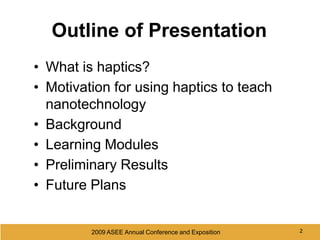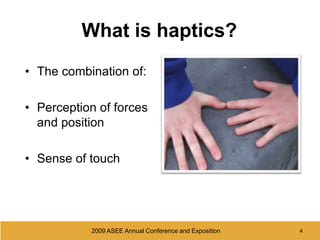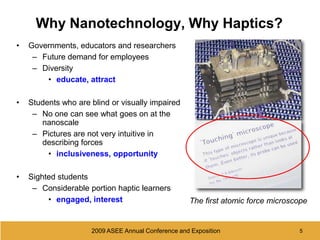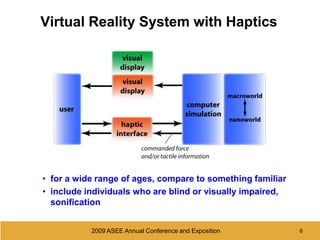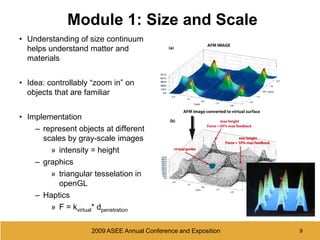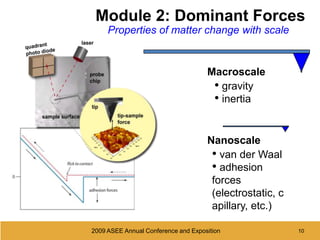Teaching Nanotechnology Using Haptics
- 1. 2009 ASEE Annual Conference and Exposition Development of a Nanoscale Virtual Environment Haptic Interface for Teaching Nanotechnology to Individuals who are Visually ImpairedDianne Pawluk1, Curtis Taylor2, Marcia Hoffman1 and Maria McClintock11Dept. of Biomedical Engineering, Virginia Commonwealth University2Dept.of Mechanical and Aerospace Engineering, University of FloridaVCUWith support from the National Science Foundation
- 2. 22009 ASEE Annual Conference and Exposition 2Outline of PresentationWhat is haptics?Motivation for using haptics to teach nanotechnologyBackgroundLearning ModulesPreliminary ResultsFuture Plans
- 3. 3Traditional Teaching of Abstract Science and Nanotechnology2009 ASEE Annual Conference and Exposition Traditional methods of teachinglectures
- 4. rely on 2-D diagrams or display
- 5. poor engagement of students
- 6. difficult to conceptualize
- 7. more difficult for visually impairedmaterialstructureatomic structureNew methods needed to increase engagement and perceptionmolecular machine3
- 8. 4What is haptics?2009 ASEE Annual Conference and Exposition The combination of:Perception of forces and positionSense of touch4
- 9. 5Why Nanotechnology, Why Haptics?2009 ASEE Annual Conference and Exposition Governments, educators and researchersFuture demand for employeesDiversityeducate, attractStudents who are blind or visually impairedNo one can see what goes on at the nanoscalePictures are not very intuitive in describing forcesinclusiveness, opportunitySighted studentsConsiderable portion haptic learnersengaged, interestThe first atomic force microscope5
- 10. 62009 ASEE Annual Conference and Exposition Virtual Reality System with Hapticsfor a wide range of ages, compare to something familiar
- 11. include individuals who are blind or visually impaired, sonification6
- 12. 72009 ASEE Annual Conference and Exposition State-of-the-art in HapticsHapticstraining
- 13. surgery, flying aircraft, etc.
- 15. teachingPhantom (> $10,000)SideWinder (< $50)Novint Falcon affordableforce feedback device, with position information
- 16. easily replicated in a classroom
- 17. allows for interactive, multi-sensory exploration of nanoscale concepts for sighted and visually impairedNovint Falcon (< $200)7
- 18. 82009 ASEE Annual Conference and Exposition What are the big ideas in nanotechnology?1. Size and Scale2. Dominant Forces3. Structure of matter4. Instrumentation5. Nanomachines6. Nanoscale FabricationScienceEngineering8
- 19. 9Module 1: Size and Scale2009 ASEE Annual Conference and Exposition Understanding of size continuum helps understand matter and materialsIdea: controllably “zoom in” on objects that are familiarImplementationrepresent objects at different scales by gray-scale imagesintensity = heightgraphicstriangular tesselation in openGLHapticsF = kvirtual* dpenetration9
- 20. 10Module 2: Dominant Forces2009 ASEE Annual Conference and Exposition Properties of matter change with scaleMacroscale gravity
- 21. inertiaNanoscale van der Waal
- 22. adhesion forces (electrostatic, capillary, etc.)force10
- 23. Preliminary ResultsFor Teaching Nanoscale Science and EngineeringTouching AtomsInteractive NanofabricationUnderstanding Atomic PotentialsFalcon Force-Feedback Controller
- 24. 12Conclusion2009 ASEE Annual Conference and Exposition Developed new haptic-based, interactive simulations to teach abstract science and nanotechnology concepts
- 25. Developed learning modules to teach concepts of
- 26. size and scale
- 27. dominant forces
- 28. Demonstrated to prototype to elementary school, undergraduate and graduate students
- 29. extremely positive reaction
- 30. Will validate using:
- 33. compare to: vision alone and traditional methods 12

